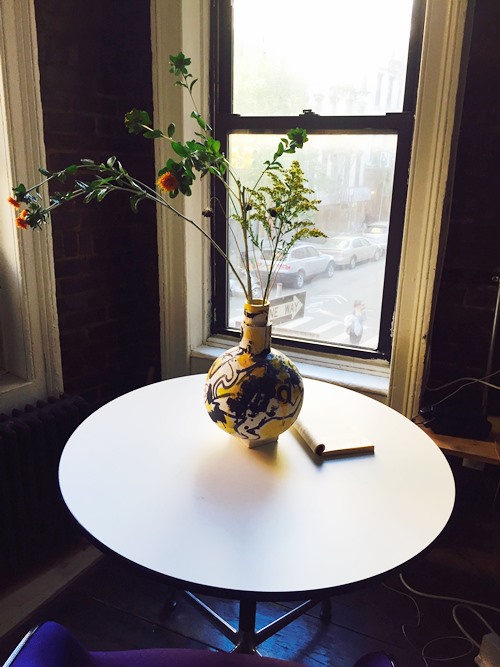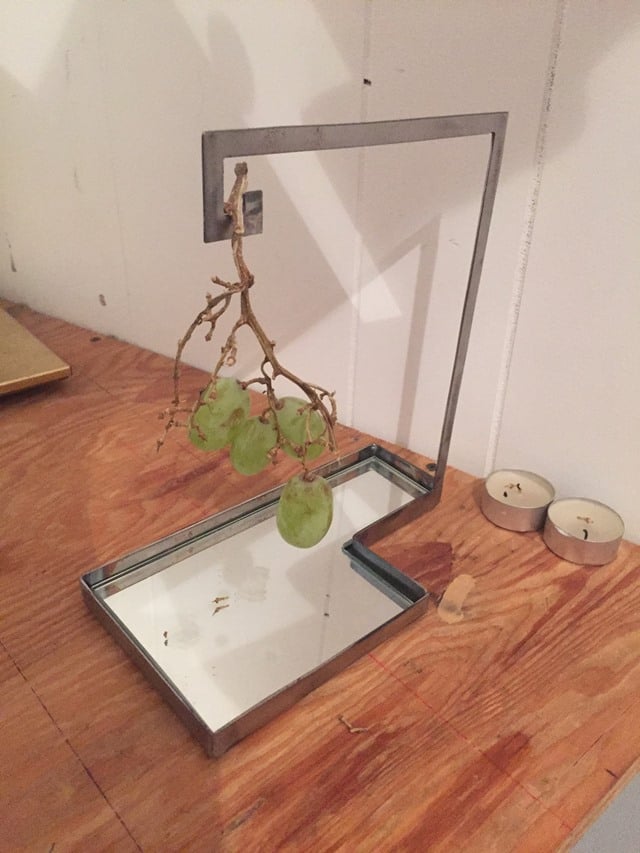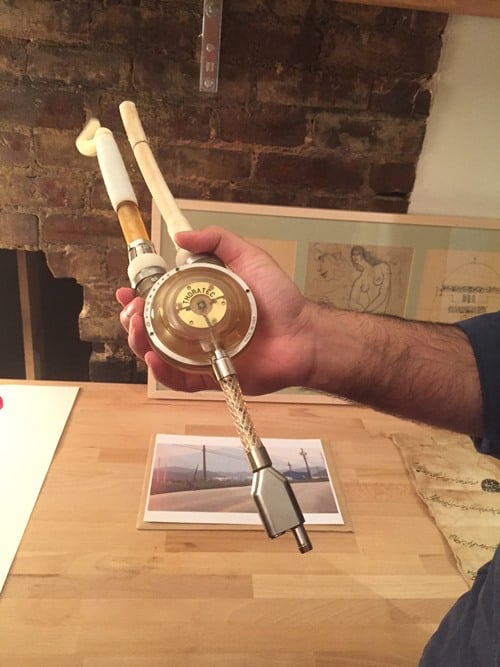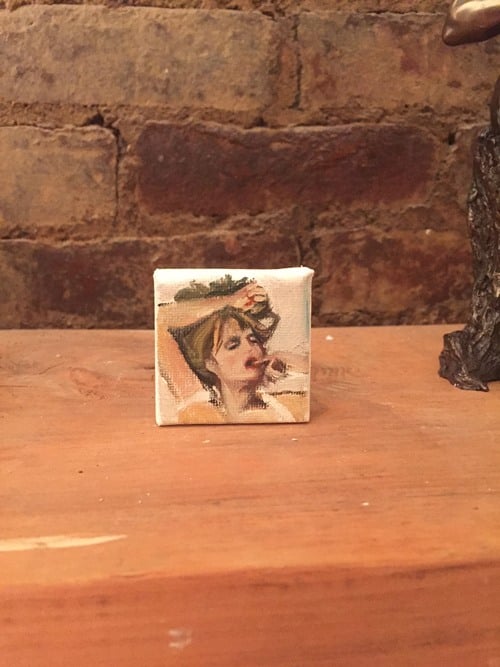Art & Exhibitions
For ‘Home Show,’ Asad Raza Brings Works by Prominent Artists to His Soho Apartment
Don't miss Adriàn Villar Rojas's still life in the freezer.

Photo Asad Raza.
Don't miss Adriàn Villar Rojas's still life in the freezer.

Brian Boucher

“I’m mortified that people are seeing these,” artist Asad Raza told me, standing in the tiny bedroom of his New York apartment on a recent afternoon. He was gesturing to two artifacts from his childhood: an ersatz Star Wars bedspread covered in speeding spaceships and a cat pillow with cute whiskers.
The embarrassing bedding is an intervention by artist Rachel Rose, who dictated that Raza use it for the duration of “The Home Show,” a by-appointment exhibition that includes more than two dozen artworks and objects by as many contributors. The participants range from (ahem) household names like Dan Graham and Tino Sehgal to non-artists like both of Raza’s parents, as well as younger invitees including Deanna Havas and Ian Cheng.
As distinct from an art collection, which forms a sort of self-portrait, this particular show, which consists entirely of works on loan, forms a slightly different kind of self-portrait at a certain moment in time. It also serves as a portrait of Raza’s personal and professional circle, since he invited only artists he knows personally to contribute.
Though he’s worked previously helping other artists produce their shows (Sehgal at the Guggenheim, Phillippe Parreno at the Park Avenue Armory), he’s coming into his own as an artist, having participated in the recent Ljubljana Biennial of Graphic Arts and in the projects section at the Frieze art fair in London this past fall. Following all that travel, he said, he was happy to devise a project that would keep him home during the holiday season.
Raza’s work is often social and interactive. At Frieze, performers told stories to visitors and to each other; in Ljubljana, he created a temporary school. After greeting me on the sidewalk, he walked me up one flight to his apartment, where I met Nicola Lees, the Frieze Foundation curator who included Raza in the London fair, and Silvia Sgualdini, who told me she’s “a curator in disguise” though she’s a director at London gallery Pilar Corrias. Also dropping in for part of the tour was Florence Derieux, who was recently appointed curator of American art at the Centre Pompidou Foundation.
Raza led us about, introducing the works one by one in an unaffected style. By that time, he’d been leading tours for three weeks already, so if his presentation was a bit brisk, you couldn’t blame him.
Near the front door was another contribution by Rose, in the form of several garbage bags. “This is all stuff she decided I should throw away,” he said. “She edited my life. At first I felt very excited. I thought, ‘You’re going to subtract instead of add, and edit instead of make something.’ As it got closer, I felt like, ‘This is a terrible idea. She’s gonna throw away my things.’ But when she did I felt very uplifted somehow.”
Several other works were also created just for Raza’s home and based on his possessions.
A book sits on a table in the corner, next to a painted vase. “Camille Henrot borrowed three books, and made the work based on The Human Nature of Birds.” Subtitled A Scientific Discovery with Startling Implications, by Theodore Xenophon Barber, the volume lay open to a page where Henrot has underlined the sentence “Birds also have a beak language.”
Henrot made the vase, painted it, and dictated the flower arrangement. “The biggest thing for me has been remaking the arrangement every few days according to her instructions, since I never knew much about flowers before,” Raza said.

Adriàn Villar Rojas, Untitled (2015).
Photo: Brian Boucher.
Also based on flora obtained in the neighborhood is a still life in the freezer by Adriàn Villar Rojas. Raza warned us that he could hold the door open for only a few seconds, and when he did, abundant grapes, a melon, a pomegranate, and even a lobster came into view, along with a few bottles of Corona. The cap on one of the bottles had burst, leaving a frozen waterfall of beer. They all slump over the course of each day as the climate control is compromised with the regular openings, he said, but are refreshed each night as the low temperature is restored. Many of Rojas’ giant sculptures are made with decay in mind; this work brought similar sentiments to a small scale.
Both Sgualdini and I spent several of those seconds photographing the piece, me for visual note-taking, her for Instagram. So I barely saw it, I told Raza afterward.
“Yeah,” he said. “That was a mistake.”

Nick Mauss, Untitled (2013).
Photo: Brian Boucher.
Similarly affected by the passage of time, and periodically refreshed, is a contribution by Nick Mauss, a tiny sculpture in which a handful of grapes dangles from a hook above a mirrored base. Mauss dictated that it should hang next to the artist’s bed, and that Raza should eat a few each day. “It seems like Bacchus when it’s new,” said Raza, “but somehow forlorn when most of them are gone.”
The home setting suggests intimacy, and both emotional and bodily familiarity form a theme. For example, there’s a portrait of Raza composed in a scent by his sister, who is the perfumer behind Régime des Fleurs.
“It smells like man,” Sgualdini said with a giggle.
Other works actually penetrate the body, like the toothpastes provided by Carsten Höller, which were in the bathroom. “They’re called male, female, and infantile,” said Raza, “and supposedly, as I use them, my dreams will take on those different characteristics.” Since there’s about a two-week supply, Raza is saving them for the tail end of the show.

Syed Tasnim Raza, Untitled (2015).
Photo: Brian Boucher.
A device on a table in the living room penetrated a body much more profoundly: a device that was implanted into a patient by Asad’s father, a heart surgeon, that assisted his heart in beating as he awaited a heart transplant. Raza pointed out just which parts went inside the man’s chest, and where the blood came out via tubes. I wasn’t alone, Asad said, in feeling a bit faint on studying the object, which looked frighteningly low-tech.

Jo Sander, Untitled (2015).
Photo: Brian Boucher.
On a shelf above that mechanism stood a tiny oil painting, a couple of inches wide, by Jo Sander, showing the head torso of a woman, her eyes closed, one finger in her open mouth. “Every week she comes and replaces it, in a series of untitled paintings,” said Raza. “At some point, I think after the third one, I asked her, ‘Are these all of women having an orgasm?’ And she said, ‘Yeah, you didn’t know that?’ And I felt really embarrassed.”
There is plenty of other work packed into the artist’s crib, such as a gaming app by Cheng that Raza is beta-testing, a video by Jordan Wolfson that is screening on a laptop, a painting by Sarah Morris propped up next to his bed, a Shahzia Sikander drawing on the kitchen counter, and, on the shelf near the Sander oil, a mastodon tooth from about 15,000 years ago.
Near the end of the tour, as Raza walked through the living room, he bent over, and looked over his shoulder at his guests. In a growling voice, as though he had been possessed by a demon, he asked us, “What do you think this is about?” Then he calmly straightened up. The creepy query wasn’t Raza turning weird on us. He was, he explained, carrying out a performative work by Tino Sehgal. But the question did prompt us to start talking to each other, after which he went into character again and asked us once more what we thought the piece was about. This time around, it was revealed that the work is concerned with the way conversation influences how we make sense of art.
“The Home Show” is on view through December 20 and is open by appointment, Wednesday-Sunday, 2 p.m.—8 p.m. Contact the artist to set up an appointment at [email protected].